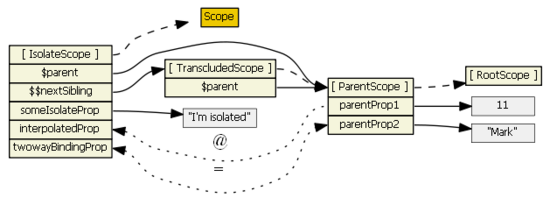本文转载自: http://www.tuicool.com/articles/63iEref
angular中scope的继承与js的原型继承有密切的联系,首先回顾一下js的继承:
function ParentScope(){ this.aString = "parent string"; this.aNumber = 100; this.anArray = [10,20,30]; this.anObject = { 'property1': 'parent prop1', 'property2': 'parent prop2' }; this.aFunction = function(){ return 'parent output'; } } function ChildScope(){ } ChildScope.prototype = new ParentScope();
ChildScope.prototype.constructor= ParentScope;
var childScope = new ChildScope();
ChildScope继承自ParentScope,关系图如下:
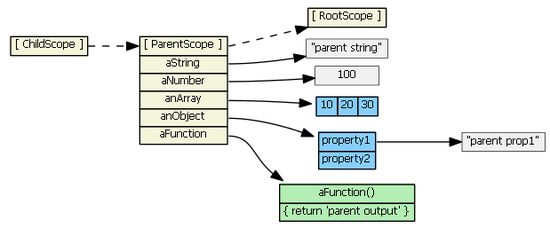
如果我们要在 childScope 上查询一个定义在 parentScope 的属性, JavaScript 会先在 childScope 上查找, 如果没有查到, 那么会顺着原型链去查找. 所以以下判别式均为 true
childScope.aString === 'parent string' childScope.anArray[1] === 20 childScope.anObject.property1 === 'parent prop1' childScope.aFunction() === 'parent output'
接下来做如下操作
childScope.aString= 'child string'
原型链将不会被访问, 一个新的 aString 会被加入到 childScope 的属性中去, 新的属性会隐藏 parentScope 中的同名属性:
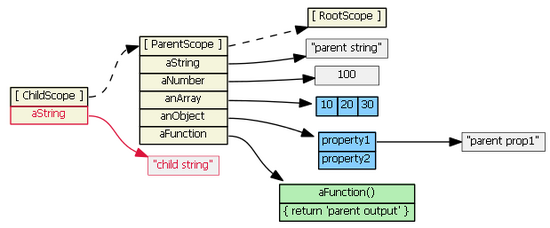
再这么做:
childScope.anArray[1]= 10;
childScope.anObject.property1= 'child prop1';
原型链被访问了. 因为 anArray , anObject 没有在 childScope 中找到.
新的赋值操作均在 parentScope 上进行. childScope 上没有添加任何新的属性.
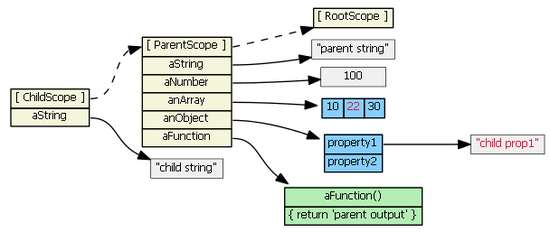
但如果我们做如下操作:
childScope.anArray= [100, 555];
childScope.anObject= {name: 'Mark', country: 'USA'}
原型链没有被访问, childScope 会获得两个新的属性, 并且会隐藏 parentScope 上的同名属性.

仔细分析, 第一第三次均是对某个属性直接进行赋值, 原型链并不会被访问, 由于属性并不存在, 所以新的属性将会被添加.
而第二次其实是先访问 , 再赋值,原型链就会被打开。
--------------------------------------------------------------------------------------------------------------------------------------------------
再来看Angular scope的继承
以下指令汇创建新的scope,并且在原型上继承父scope
ng-repeat, ng-switch,ng-view,ng-controller
带有scope: true的指令,带有transclude:true的指令
值得注意的是以下指令不会继承父scope
scope: {}的指令,这会创建一个隔离作用域
scope: false ,这会共享作用域
让我们看几个例子:
ng-include
JS:
$scope.myPrimitive = 50;
$scope.myObject = {aNumber: 11};
HTML:
<p>{ myPrimitive }</p>
<p>{ myObject.aNumber }</p> // cannot use double curly brackets in jekyll
<script type="text/ng-template" id="/tpl1.html">
<input type="number" ng-model="myPrimitive">
</script>
<div ng-include src="'/tpl1.html'"></div>
<script type="text/ng-template" id="/tpl2.html">
<input type="number" ng-model="myObject.aNumber">
</script>
<div ng-include src="'/tpl2.html'"></div>
每一个ng-include都会创建一个子scope, 并在原型上继承父scope

向第一个 input 输入数字, 一个新的属性 myPrimitive 将会被创建, 同时隐藏 父 scope 的 myPrimitive ;

向第二个 input 输入数字, 子 scope 并不会创建一个新的属性, 这时候原型继承发挥了作用

第一种情况很可能不是我们期待的结果, 所以可以显式的调用 $parent 来解决这个问题.
<input type= "text" ng-model= "$parent.myPrimitive"/>
向第一个 input 键入数字, 这时候就不会产生新的属性了. $parent 指向了 父scope. 但是 $parent 和 原型上的继承并不一定相等. 稍后我们会看到一个例子.

对于所有的 scope, 无论是共享的( scope: false ), 继承的( scope: true ), 还是孤立的( scope: { ... } ),
Angular 都会建立一个 父-子 的层级关系, 这个层级关系是根据 dom 结构的层级关系决定的, 可以通过 $parent , $$childHead , $$childTail 来访问.
-----------------------------------------------------------------------------------------------------------------------------------------------------------------------------------------------
ng-switch、ng-view
情况与ng-include一样,不赘述
-----------------------------------------------------------------------------------------------------------------------------------------------------------------------------------------------
ng-repeat
ng-repeat有一些特殊
$scope.myArrayOfPrimitives = [ 11, 22 ];
$scope.myArrayOfObjects = [{num: 101}, {num: 202}]
<ul><li ng-repeat="num in myArrayOfPrimitives">
<input ng-model="num"></input>
</li>
</ul>
<ul><li ng-repeat="obj in myArrayOfObjects">
<input ng-model="obj.num"></input>
</li>
</ul>
对于每一次迭代, ng-repeat 都会创建一个 子scope, 并在原型上继承 父scope, 但是他还会将 父scope 上的属性赋值到 子scope 上 . 新的属性名就是 ng-repeat="** in parentScope.property"中的 **.
源码中的 ng-repeat 是这样的:
childScope = scope.$new(); // child scope prototypically inherits from parent scope ...
childScope[valueIdent] = value; // creates a new childScope property
如果 ** 是 primitive, 那么一份 copy 会被赋值到新的属性上. 修改 子scope 上的新属性自然不会修改 父 scope 上的属性.
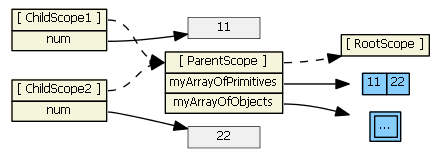
如果 ** 是个 object, 那么一个 reference 会被赋值到新的 子scope 属性上. 修改这个属性, 就是修改 父scope 对应的属性.

ng-controller
ng-controller 也是会创建新的 子scope, 同时原型继承 父scope. 如同 ng-include, ng-switch, ng-view.
但是, 使用 $scope 来共享数据被认为是一种不好的操作. 因为原型链可是会一直向上追溯的.
如果想要共享数据, 最好使用 service
--------------------------------------------------------------------------------------------------------------------------------------
directive
我们来总结以下指令中的 scope:
1.scope: false 指令不会创建新的 scope, 没有继承关系. 与 $parent 共享 $scope
2.scope: true 指令会创建一个 子scope, 并在原型上继承 $parent. 如果在一个 DOM 上有多个指令想要创建新的 scope, 会报错.
3.scope: {...} 指令会创建一个 孤立的scope. 这在创建可重用的组件时是最好的选择. 但是, 即使如此, 指令还是希望读取 $parent 的数据.
transclude
指令创建了一个 “transcluded” 的子scope, 在原型上继承其 父scope. 如果上述例子同时具有 transclude: true . 那么这个 “transcluded” scope, 和 “islolated” scope 是姊妹关系. 他们的 $parent 指向同一个 scope. 且 isolate scope 的 $$nextSibling 就是这个 “transcluded scope”. 下图反应了他们之间的关系:
